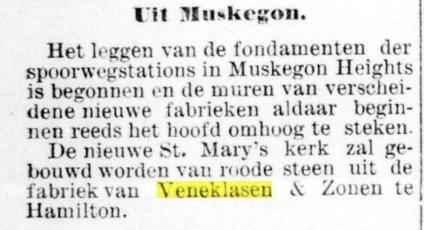Since writing my first book, Veneklasen Brick, in 2004, I never did any additional research on the topic of the Veneklasen family, their brickyards, and the Dutch American building tradition using their bricks. Mostly this was because I felt that by the time the book was published in 2005, I had learned just about everything I was ever going to learn about the Veneklasen brickyard (the Zeeland Brick Co. after 1892), and if I learned anything else, it was bound to be insubstantial. My only holdout hope, however, was that I would find business records of the company.
Well, that never happened.
But, I have found a new source to use to add something to the story. That is the digitized version of De Grondwet, the Dutch language newspapers published in Holland, Michigan. With simply search terms (Veneklasen, Veneklassen, Veneklaasen, brickyard, steenbakkerij, etc) at Delpher.nl, I was able to pull up dozens of relevant hits from the 19th and 20th century. Of course all the article are in Dutch, so I’ll show a few below and provide some translations while explaining the additions to the story.
In July 6, 1875, a substantial article gives account of the firm. They made about 30,000 bricks per day, both white and red, but the white were in higher demand. They had two machines in operation, one was a steam-driven 25-horsepower machine, the other, driven by four horses ( by the way – did you know that a horse actually has a lot more than 1 horsepower? look it up). The factory had 40 acres, of which 10 acres of clay ground were in use, with no chance of running out of clay anytime soon. The factory burns about 1,000 cords of wood per year, employs 30 men, pays men in cash at the end of every week. They built new sheds last year, and produced about 700,000 bricks in the spring of 1875.
About every 10 years, the newspaper would send a reporter to the factory and write up a short, basic article. Often, they praised the factory for giving jobs to men in the area, for the industry and intelligence of the family that operated it. The brickyard was also a sign of progress. From mules to steam-power, from a few thousand bricks to millions. It was a perfect place to report on progress and improvement, because one could count the bricks, or at least estimate them, and see the new machinery that the family bought from Pittsburgh or Chicago.
I’ve long been convinced that the 1880s were a boom-time in West Michigan, and in the country more generally. Often this is called the “gilded era” as if it were gold on the outside, but something less valuable under the surface. Production numbers don’t lie, though. More brick houses were built in the 1880s in Ottawa County than in any other decade. The Veneklasen brickyard sold more bricks in the late 1880s and early 1890s than in any other period in its 70+ year run.

De Grondwet, March 18, 1890
With demand for brick at an all time high, the Veneklasens looked to expand their business. In 1890, they bought a brick oven and brickyard in Hamilton, Michigan. In writing my book, I didn’t know how much they had paid for it: $7300. Quite a sum for the day.

De Grondwet, April 1, 1890
Soon, they built a telephone line to connect their two plants: Zeeland and Hamilton.
From Hamilton, MI, they shipped bricks to Muskegon to build St. Mary’s Church in Muskegon Heights. Look at their church building (yup, it looks like Veneklasen Brick).

De Grondwet, October 7, 1890
Demand was so high that the Veneklasen’s Zeeland, Michigan yard continued work in the winter. By tradition, brick-making was a summer activity, because in earlier times, the sun was needed to help dry the bricks.

De Grondwet, December 9, 1890
The August 15, 1893 issue gives a short, basic history of the company reports of a downturn in the work at the factory: “only 40” at work that summer.
The business was already on a downward slide in the 1910s, but a serious of fires at various (perhaps abandoned?) sites pushed it over the edge. First, a loss of $12,000 at their Kalamazoo factory (Kalamazoosche Fabriek – for those Dutch speakers out there) reported in the April 10, 1906 issue of De Grondwet. Nothing was insured. In July , 1922, a $5000 fire in Hamilton, again with no insurance.
A number of other articles report on injuries sustained at work at the brickyard, or a horse (12 years old, fox-colored, 1000 or 1100 pounds) that ran way from the factory (De Grondwet, July 22, 1879).
All in all, what these clippings seem to reinforce the idea that the factory was an important part of the community. Farmers brought wood to sell to the factory, and bought bricks in return. The Veneklasen family became a benefactor in the area, and the family grew, with many children in each generation.







Hi Michael! I have enjoyed your detailed work on the company and lasting cultural impact of Veneklasen Brick. In your work, did you get what you felt was a credible genealogy for the family “in the old country?” The amateur trees on Ancestry and the like have parents for Jan Hendrik who were about his same age, and died after he did, which seems highly unlikely.
Grazie!
LikeLike
Hi Michael! I have enjoyed your detailed work on the company and lasting cultural impact of Veneklasen Brick. In your work, did you get what you felt was a credible genealogy for the family “in the old country?” The amateur trees on Ancestry and the like have parents for Jan Hendrik who were about his same age, and died after he did, which seems highly unlikely.
Grazie!
LikeLike
Hi Michael! I have enjoyed your detailed work on the company and lasting cultural impact of Veneklasen Brick. In your work, did you get what you felt was a credible genealogy for the family “in the old country?” The amateur trees on Ancestry and the like have parents for Jan Hendrik who were about his same age, and died after he did, which seems highly unlikely.
Grazie!
Greg Veneklasen
LikeLike
I am wondering if you think that this house in Kalamazoo would have been built with Veneklasen bricks and if you consider it an example of the Dutch style that was being built in SW Michigan in the 19th century.My great-grandfather, a brick mason and contractor, built it. He immigrated as a kid with his parents first to Zeeland before coming to Kalamazoo, so he –or at least his father–would have been familiar with the architecture in Zeeland. https://thefamilykalamazoo.files.wordpress.com/2014/10/img_0526-copy.jpg
LikeLike
Thanks for the comment, Luanne. Veneklasen did own brickyards in near Allegan and Kalamazoo, so their bricks were certainly used in that area. And you are correct that there is a similar style of white/ red polychromatic brickwork in this house as in the Dutch areas of Ottawa and Allegan Counties. I never researched Dutch homes in Kalamazoo, but I wonder if there might be a connection, and it’s fascinating that you have suggested a possible one. I wish I knew the answer to your question.
LikeLiked by 1 person
I always thought the brickwork was distinctive and didn’t know if it originated in the Netherlands or if it was my great-grandfather’s trademark!
LikeLike
Hi Luanne – the polychome brick style was from “the Old Country”, carried over by the settlers along with place names to feel at home in W. MI. Best, Greg V.
LikeLike